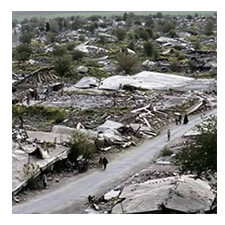On April 24, 1974, the Regime bombed the city of Qaladze with several warplanes, resulting in hundreds of civilians from all walks of life being martyred and wounded.
In 1974, the Iraqi government withdrew from the March 11, 1970, agreement, and war and destruction once again swept the Kurds throughout the revolutionary regions. Because the people wanted peace and a comfortable life, they were very concerned about this government's attitude and stood firmly against it. Therefore, with the resumption of the war, the whole masses, including all classes, resisted the government's attack. The struggle of the pen joined the struggle of the weapon with greater intensity. Students, teachers, intellectuals and revolutionaries from Sulaimani University went to the areas under the control of the revolution and rejected the Ba'athist rule. Sulaimani University combined scientific struggle with armed struggle. In other words, both the flags of science and revolution were raised together to prove to the world that war and destruction constitute a significant obstacle to Kurdish progress, and oppression has filled all parts of the Kurdish people's lives, including science and knowledge.
Successive Iraqi regimes have always been a steel obstacle to Kurdish progress and have tried every way to stop the caravan of struggle, revolution and progress and finally vandalize it. For this reason, on the morning of April 24, 1974, at 9:45 am, several warplanes bombed the city of Qaladze with prohibited Napalm bombs.
The Regime poured its hatred and anger on the university, science, and the civilian population of the city, targeting the university center intensely and subjecting the city to a tragedy that cannot be accepted by any moral, conscientious and humanitarian standards. In an instant, 123 women, children, older people, youth, students, teachers, workers and farmers were martyred, and more than 400 people were injured.
This was the most significant tragic epic that ever happened, and It was utterly mixed with other accounts of the struggle and the train of the September Revolution. It was a shameful gift from the Soviet Union and its allied Ba'athist government to the Kurds, described in the newspaper Le Monde on June 10, 1974, as the most terrible disaster.
The martyrs of this historic tragedy were buried in the cemetery of Qaladze city, and the cemetery was named after them. On the one hand, however, this heartbreaking tragedy was a shame to its perpetrators. On the other hand, it shook the conscience of all Kurds and Kurdistanis and became a living lesson in the hearts of every freedom fighter, commemorated yearly. In the successive uprisings of 1982, 1983, and 1987, the anniversary of the Bombing of Qaladze was hailed as a historical day by the revolutionaries. Voices of protest were raised in all Kurdish cities by sections of the masses against the Ba'ath regime. Residents of Qaladze City annually commemorate this historical tragedy and condemn the perpetrators.
Resources:
• خۆشەوى عەلى کانیەلنجى: بیروەریەکانى عەزیز قازى حەمەد سورچى، چاپخانەى دانیشفەر، هەولێر، ٢٠٢٣.
• مسعود بارزانی: بارزانی و بزوتنەوەى ڕزگاریخوازی کورد، بەرگی سێیەم، بەشی یەکەم، شۆڕسی ئەیلوول ١٩٦١-١٩٧٥، چ: یەکەم ٢٠٠٤.
• ئارى کەریم: چەند لاپەڕەیەکى زیندوو لە شۆڕشى ئەیلوولدا، چاپخانەى خەبات، دهۆک ١٩٩٩.
• ئیسماعیل گوندەژۆرى: شۆرشى ئەیلول لە باڵەکایەتى، چاپخانەى رۆژهەڵات، چاپى یەکەم، ٢٠١٨.
• ئیبراهیم جەلال: باشورى کوردستان و شۆڕشى ئەیلوول بنیادنان و هەڵتەکاندن ١٩٦١- ١٩٧٥، چاپی چوارەم، ٢٠٢١.




